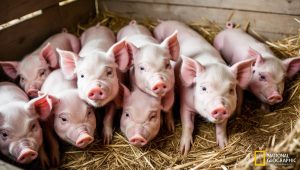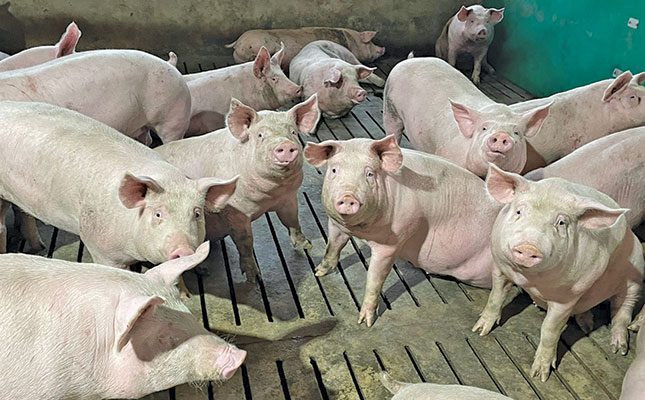Effective pig farming requires a delicate balance of care, precision, and innovation to ensure the well-being and performance of weaners and growers.

Managing weaners and growers effectively is a cornerstone of success in pig farming. This phase in the production cycle, spanning from weaning to the finishing stage, is critical for achieving optimal growth, maintaining animal welfare, and securing profitability.
Mismanagement during this period can lead to significant health challenges, reduced productivity, and ultimately financial losses.
Pig housing
Dr Alex Westerink, a swine health and production expert at CS Vet in Pretoria, Gauteng, says the design of pig housing is a major determinant of the health and productivity of weaners and growers.
Proper housing provides a comfortable environment that supports the animals’ growth and allows the farmer to efficiently manage their herd.
He adds that housing must strike a balance between cost-effectiveness and animal welfare: “Good housing design considers the size of the herd, future expansion needs, and operational efficiency.”
Key housing design considerations are as follows:
- Stocking density: Overcrowding in pens increases stress and reduces feed efficiency. Recommended stocking densities are a minimum of 0.4m² per pig for weaners (up to 35kg each) and 1m² per pig for growers/finishers (up to 110 kg each). Westerink advises that farmers also take into consideration their future space requirements.
- Ventilation: Proper ventilation is essential to prevent the build-up of harmful gases, such as ammonia, and to reduce the risk of respiratory disease.
- Ease of monitoring: Housing layouts should allow farmers to easily observe pigs for signs of illness or underperformance.
Additionally, modern housing solutions incorporate climate-control systems to maintain consistent temperatures and humidity levels. Westerink recommends that farmers invest in housing that can accommodate larger litters, as modern breeding programmes are producing more prolific sows.
Feed efficiency
Feed accounts for up to 70% of total production costs in pig farming, making feed efficiency a top priority. Westerink says achieving the right balance between feed cost and performance is critical.
“High-quality feeds often produce better growth rates, but farmers must ensure the investment yields returns,” he explains.
To optimise feed efficiency, Westerink recommends:
- Conducting feed trials to evaluate different formulations and their impact on growth, feed conversion ratios, and cost effectiveness;
- Adjusting diets based on the specific nutritional needs of weaners and growers at different growth stages; and
- Monitoring environmental factors like temperature, as pigs expend more energy maintaining body temperature in extreme conditions.
Animal health
When it comes to managing farm economics, veterinary costs play a role but are not typically a dominant factor.
“Veterinary costs in the big picture are probably not that massive,” says Westerink. These costs, however, vary significantly, depending on the farm’s health: “High-health farms generally have lower vaccination and treatment costs because they have fewer health challenges,” he adds.
Biosecurity remains a key consideration for farms of all health levels. “High- and conventional-health farms must have very strict biosecurity measures in place to prevent the introduction of diseases in Africa, such as African swine fever and foot-and-mouth disease,” explains Westerink.
Such measures are crucial to safeguard farm operations against potentially devastating outbreaks.
Vaccinations are a critical component of maintaining animal health and productivity on farms, with benefits extending beyond individual animals. “Vaccines like those for E. coli and EPL (erysipelas, parvovirus and leptospirosis) are given to sows to safeguard their reproductive health,” says Westerink.
He adds that these vaccines are commonly administered across most production units, if not all, and the impact of vaccinations goes beyond safeguarding the sows themselves.
Westerink says there are broader benefits of these vaccinations.
For example: “If the E. coli vaccine is given to a sow, what’s most beneficial is that you get the passive transfer of antibodies [to the piglets] through the colostrum, which is the first milk the piglets receive,” he explains.
In terms of parasites, Westerink says they are not a significant concern for most modern commercial farms. While individual units may experience minor issues, these are effectively addressed.
“Yes, there are individual units that may have a low-level [parasite] issue, but this is manageable with the implementation of the correct treatment protocol,” he adds.
Westerink says the most common parasite is intestinal roundworm, but it is not widespread. He adds that parasites have a limited impact on production.
Mange, a condition sometimes associated with farming, is generally absent in commercial pig operations. “Mange isn’t something we see that often on modern commercial farms, although it may still occur in rural units. We do monitor for it, though, so if we pick it up, it’s easy for us to get in there and implement treatment protocols,” he adds.
Stress management
Westerink describes weaning as a critical period that requires meticulous planning to minimise stress and its associated impacts.
He suggests the following strategies for easing the transition to solid feed:
- Gradual dietary transitions. Introducing piglets to solid feed earlier on helps them adjust more smoothly when they are separated from the sows. Starter feeds that are nutrient-dense and easily digestible are ideal for supporting gut health during this transition.
- Maintaining optimal environmental conditions. Proper temperature regulation is crucial to reducing the animals’ stress levels. Newly weaned piglets are particularly susceptible to cold stress, which can lead to huddling, reduced feed intake, and growth delays. The first few days after weaning are critical; thus, providing supplementary heat ensures piglets don’t waste energy trying to keep warm.
- Social stability. Minimising, regrouping and overcrowding reduces competition and fighting among pigs, thereby lowering their stress levels. Pens should be monitored closely to identify and address signs of social instability.
Monitoring growth and performance
Effective pig farming relies heavily on careful monitoring and data collection, including weighing pigs at critical points in their growth cycle.
“The most important times to weigh pigs are at weaning, when transferring pigs out of the weaner section into the grower section, and then again just prior to slaughter. These intervals ensure that weight tracking aligns with key management transitions,” says Westerink.
He emphasises the importance of minimising unnecessary handling during weighing to reduce stress and potential health risks for the pigs: “Try to weigh pigs only when you need to move them. This approach avoids excessive movement on and off the scale, ensuring a smoother operation.”
Environmental sustainability
Modern pig farming increasingly emphasises environmental sustainability, aligning with global efforts to reduce agriculture’s ecological footprint. Westerink says the following sustainable practices can also support profitability:
- Efficient waste management. Recycling pig manure for use as fertiliser not only reduces waste but also enhances soil health in crop production.
- Precision feeding. Optimising feed formulations minimises nutrient excretion, reducing the environmental impact of farms.
- Energy efficiency. Investing in renewable energy systems, such as solar panels, can lower utility costs and reduce carbon emissions.
Leveraging technology for better management
Advancements in technology are transforming pig farming, offering tools that improve efficiency and animal welfare. Westerink says there are several innovations that can benefit farmers.
Automated feeders ensure precise feed delivery, reducing waste and ensuring consistent nutrition, while climate-control systems help create optimal living conditions for pigs. Wearable technology and remote sensors enable real-time tracking of health indicators, allowing for the early detection of illness.
However, while frequently used in Europe and other regions, wearable technology is not yet commonplace in African pig farming.
“Although some local farms do make use of [these devices], it’s not very common, but they may become more popular as technology improves and becomes more cost-effective.
“The sensors we do typically use include temperature probes, which are sufficient for the current needs of most farms.
“Technology must align with the specific needs and scale of your farm, and is very dependent on practicality, effectiveness, and price,” he explains.
Building resilience for future challenges
The pig farming industry faces ongoing challenges, including fluctuating feed prices, evolving consumer preferences, and stricter regulations on animal welfare. Westerink advises farmers to adopt a proactive approach to building resilience, including:
- Diversifying revenue streams. Explore alternative markets or value-added products, such as processed pork or branded goods.
- Strengthening biosecurity. Preventing disease outbreaks is more cost-effective than managing them.
- Investing in research and education. Staying informed about industry trends and emerging technologies ensures farmers remain competitive.
Managing weaners and growers is a multifaceted endeavour that requires attention to detail, strategic planning, and a commitment to animal welfare.
By implementing tailored vaccination programmes, reducing the animals’ stress levels, optimising their housing, and adopting innovative technologies, farmers can achieve healthier herds and improved profitability.
Westerink highlights the importance of adapting management practices to meet the unique needs of each farm: “Successful pig farming is about understanding your animals and creating an environment where they can thrive.”
READ ALSO: Essential Nutrients for Growth and Productivity
Proper nutrition is vital for maximizing livestock and poultry production. A well-balanced diet ensures rapid growth, high reproduction rates, strong immune systems, and quality end products such as milk, meat, and eggs.
Six Essential Nutrients for Livestock and Poultry
✅ 1. Proteins – For muscle growth and tissue repair…
READ ALSO: Prevention of Disease and Health Management in Poultry farming
Poultry farming requires careful attention to the health and well-being of the birds. Effective health management is crucial for the success and profitability of a poultry farm. It involves prevention, identifying, and management of health issues that can affect the flock. Proper health management practices help farmers to optimize growth and productivity of their birds, as well as minimize the risk of disease outbreaks…
Click HERE to join our WhatsApp group

